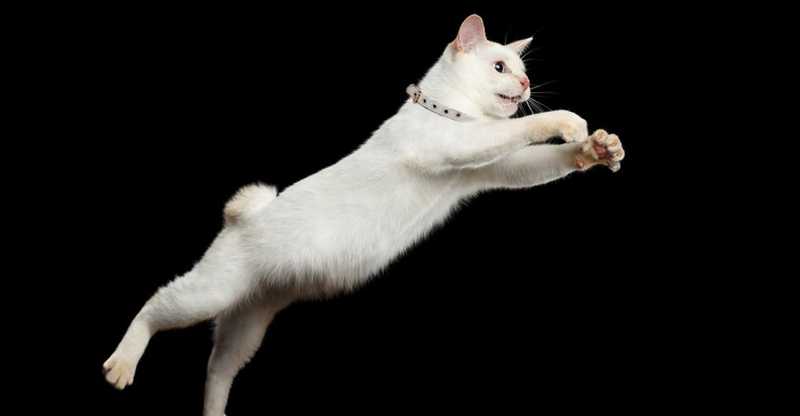How Fast Can a Cat Run, How High Can a Cat Jump & More!

As your fluffy, well-pampered cat settles in a cushy spot for her third nap of the day, it’s hard to believe that she’s a super athlete who can run faster, jump higher, and out-maneuver any of us, should it be required of her.
Admire Your Feline Athlete
As your fluffy, well-pampered cat settles in a cushy spot for her third nap of the day, it's hard to believe that she's a super athlete who can run faster, jump higher, and out-maneuver any of us, should it be required of her. Sure, you've seen her zip through the house, leap from one piece of furniture to another, spring up onto a countertop, or jump off a bookshelf – but that's child' play compared to what your cat could do, if she had to.
Humans vs. cats in running skills
It's kind of humbling to think that your cat, a purring little fluff ball, without so much as a warm-up, could out-sprint the world's fastest human runner. The fastest a human can run is about 27 mph, and that speed has been reached by only a scant few talented, well-trained athletes in top condition. Your average athlete may run up to 22 mph, and most of us ordinary folk would have trouble out-running an elephant, which can clip along at around 10 – 15 mph.
Your average healthy housecat, however, with no training, no conditioning, no stretching, and no carb loading can bolt at an amazing speed of about 30 mph. All the cat would need for such an athletic feat is a little motivation, such as fleeing prey before her or a big dog after her.
You may say that's not a fair comparison – a cat has four legs and people have just two. True, but our legs are much longer! It would seem we should be able to keep up!
According to Peter Weyand, an assistant professor at Rice University, in the Forbes article, What’s the Human Speed Limit?, four-legged animals use the same materials to run as we do – bones, muscles, and tendons, which are no different from ours. Apparently what makes the difference in speed is not how many legs we have, or how fast we can move our legs, but how much muscle force the legs can exert on the ground. Cats have very muscular legs. They also have very flexible spines that arch and straighten as they run, giving them an enormous stride.
Humans vs. Cats on the High Jump
What about vertical jumps? The world record for the high jump for humans is 8.04 feet. And according to the Guinness Book of Records, a Chinese acrobat once made a vertical jump 8.07 feet through a hoop. Ok, a cat may not be able to match that, but let's be fair – a cat is less than two feet tall! However, your average housecat can achieve a vertical jump to a height of five feet or more (without running), which may be as much as seven times her own height. We don't know the height of the aforementioned human record holder high jumpers are, but if they were four feet tall, they'd be jumping to only twice their height!
Humans vs. cats in agility
A cat has incredible agility, and in football or basketball, the average housecat could easily out-maneuver humans with her ability to make split-second starts and stops, change directions and leap over opponents. But since cats are pretty pathetic with handling a ball, it wouldn't be a game!
Cats are also tremendously flexible and graceful, capable of some stunning aerial maneuvers, and could show off their agility in a gymnastics competition. But gymnastic moves and equipment were created for the human shape, not the feline's, so there's no fair comparison.
Knowing just how athletic your pussycat really is just may answer one of those feline mysteries, which is, why do cats have that air of superiority? Yep, your cat knows. Between the two of you, she's the one who could get her picture on a cereal box or snag a major sports drink endorsement. She just doesn't want to.